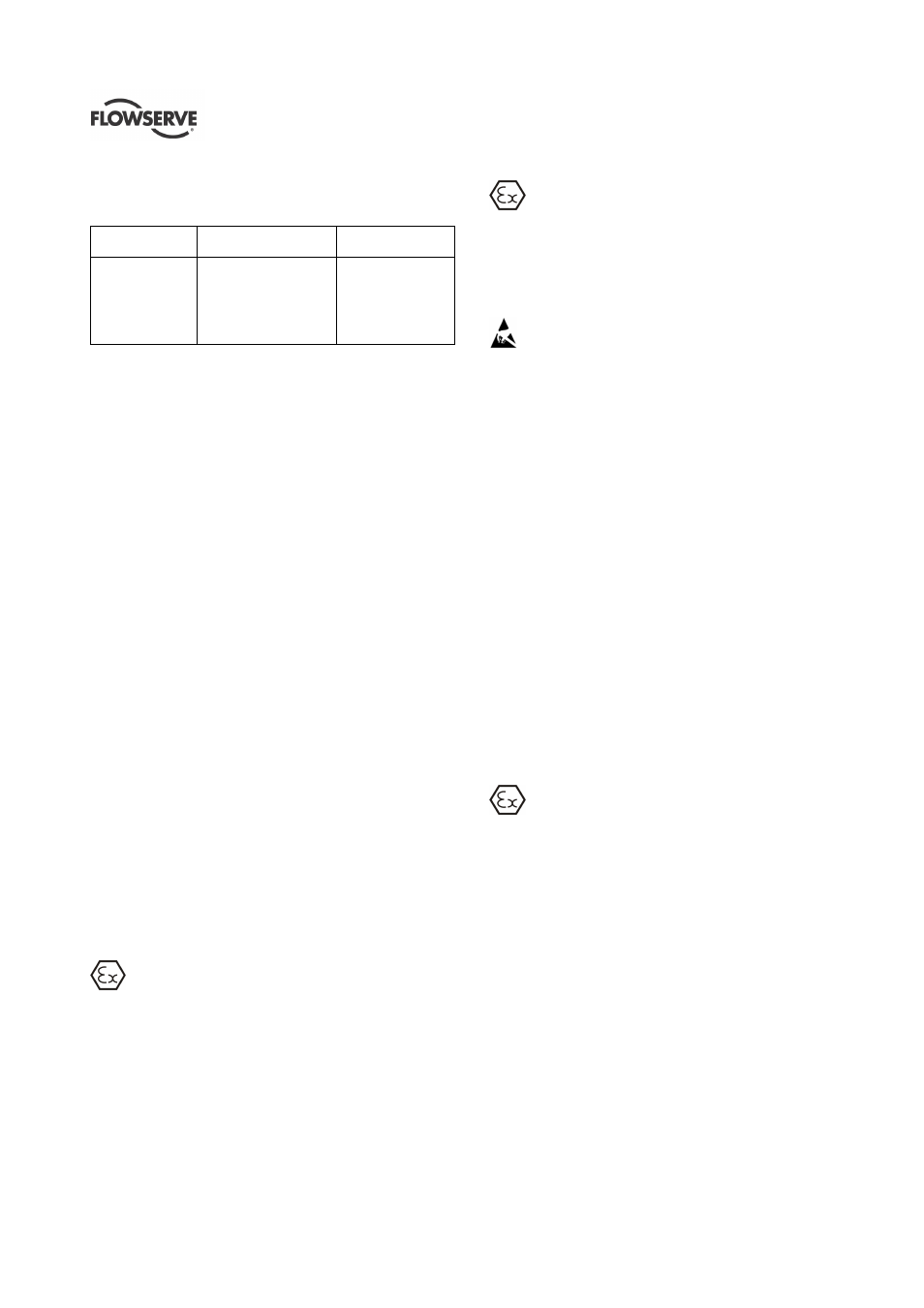Flowserve T-series Thrust Bearing Pot User Manual
Page 6

USER INSTRUCTIONS T-SERIES THRUST BEARING POT ENGLISH 26999907 01-2013
Page 6 of 24
flowserve.com
maximum permissible liquid temperature depends
on the temperature class and must not exceed the
values in the table that follows.
Temperature class
to EN13463-1
Maximum surface
temperature permitted
Temperature limit of
liquid handled *
T6
T5
T4
T3
T2
T1
85
°C (185 °F)
100
°C (212 °F)
135
°C (275 °F)
200
°C (392 °F)
300
°C (572 °F)
450
°C (842 °F)
65 °C (149 °F) *
80 °C (176 °F) *
115
°C (239 °F)
180
°C (356 °F)
275
°C (527 °F)
400
°C (752 °F)
* The table only takes the ATEX temperature class into consideration.
Unit design or material, as well as component design or material,
may further limit the maximum working temperature of the liquid.
The temperature rise at the seals and bearings and
due to the minimum permitted flow rate is taken
into account in the temperatures stated.
The responsibility for compliance with the
specified maximum liquid temperature is with
the plant operator.
Temperature classification “Tx” is used when the
liquid temperature varies and the unit could be
installed in different hazarous atmospheres. In this
case the user is responsible for ensuring that the
unit surface temperature does not exceed that
permitted in the particular hazardous atmosphere.
If an explosive atmosphere exists during the
installation, do not attempt to check the direction of
rotation by starting the unit unfilled. Even a short
run time may give a high temperature resulting
from contact between rotating and stationary
components.
Avoid mechanical, hydraulic or electrical overload
by using motor overload trips, temperature monitor
or a power monitor and make routine vibration
monitoring checks.
In dirty or dusty environments, make regular
checks and remove dirt from areas around close
clearances, bearing housings and motors.
1.6.4.4
Preventing the build up of explosive
mixtures
ENSURE THE UNIT IS PROPERLY FILLED
AND VENTED AND DOES NOT RUN DRY
It is essential to make sure that seal chambers,
auxiliary shaft seal systems and any heating and
cooling systems are properly filled.
1.6.4.5
Preventing sparks
To prevent a potential hazard from
mechanical contact, the coupling guard must be
non-sparking.
To avoid the potential hazard from random induced
current generating a spark, the baseplate must be
properly grounded.
Avoid electrostatic charge: do not rub non-
metallic surfaces with a dry cloth
;
ensure cloth is
damp.
For ATEX applications the coupling must be selected
to comply with 94/9/EC. Correct coupling alignment
must be maintained.
Additional requirement for metallic pumps on
non-metallic baseplates
When metallic components are fitted on a non-
metallic base they must be individually earthed.
1.6.4.6
Preventing leakage
Bursting of liquid containing parts due to freezing
must be avoided by draining or protecting the unit
and ancillary systems.
Where there is the potential hazard of a loss of a
seal barrier fluid or external flush, the fluid must be
monitored.
If leakage of liquid to atmosphere can result in a
hazard, install a liquid detection device.
1.6.4.7
Maintenance to avoid the hazard
CORRECT MAINTENANCE IS REQUIRED
TO AVOID POTENTIAL HAZARDS WHICH GIVE
A RISK OF EXPLOSION
The responsibility for compliance with
maintenance instructions is with the plant
operator.
To avoid potential explosion hazards during
maintenance, the tools, cleaning and painting
materials used must not give rise to sparking or
adversely affect the ambient conditions. Where
there is a risk from such tools or materials,
maintenance must be conducted in a safe area.
It is recommended that a maintenance plan and
schedule is adopted. (See section 6,
Maintenance.)
